Meteorologist warns of ‘weather wars’ between countries after Dubai floods blamed on ‘cloud seeding’ – with ‘catastrophic’ consequences
A meteorologist has warned of impending ‘weather wars’ between countries if ‘cloud seeding’ goes out of control – after flooding in Dubai sparked concerns about artificially manipulating rainfall.
Johan Jaques, a senior meteorologist at environmental technology company KISTERS, warned that there could be “unintended consequences” of using the relatively young technology, potentially leading to “diplomatic instability.”
“Every time we disrupt natural rainfall patterns, we set off a chain of events over which we have little control,” he said.
Interference with the weather also raises all kinds of ethical questions, because changing the weather in one country can lead to perhaps unintended but catastrophic consequences in another country. After all, the weather knows no intentional boundaries.’
Extreme weather and concerns about climate change and potential manipulation have gained attention in recent days, with abrupt flooding in Dubai causing widespread disruption and damage to infrastructure.
Cars are stranded on a flooded street in Dubai after heavy rain on April 18, 2024
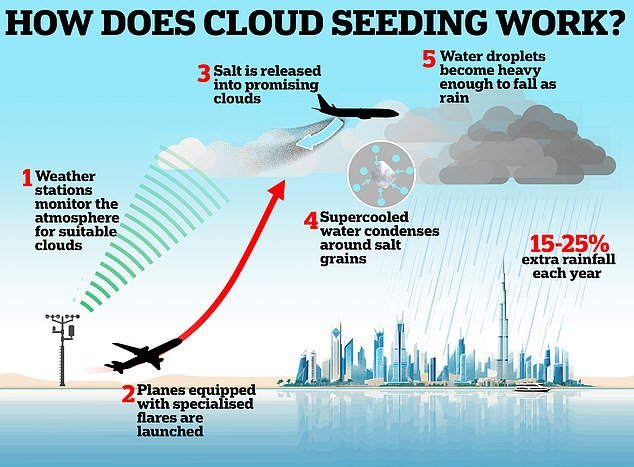
Cloud Seeding involves injecting chemicals into the clouds to cause rainfall. In the UAE, rainfall is believed to increase by 15 to 25 percent annually
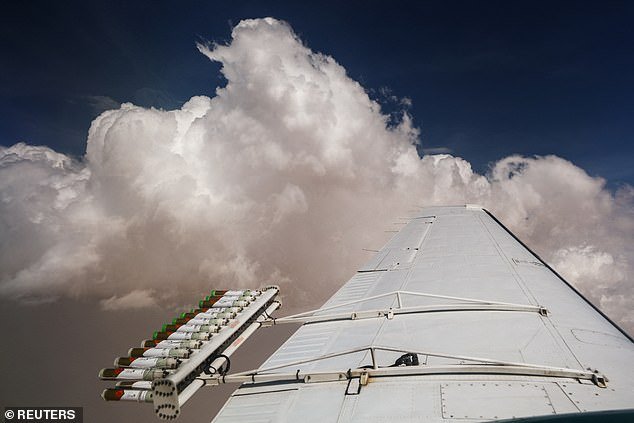
Hygroscopic flares are attached to an aircraft during a cloud seeding flight conducted by the National Center of Meteorology, between Al Ain and Al Hayer, in the UAE, August 24, 2022
The United Arab Emirates suffered terrible flooding this week that inundated the airport and many of the surrounding roads, forcing dozens of flights to be canceled as travelers crammed into the concourse to shelter from the heavy downpours.
Videos shared on social media showed cars being filled with water, forcing hundreds of motorists to abandon their vehicles and swim to safety.
The damage to the region was caused by abrupt downpours, with more than 142mm of water falling on Dubai in just 24 hours – as much as the city would normally expect in a year.
The erratic weather change raised concerns about cloud seeding, a process used since the 1940s in which planes equipped with specialized flares release salt into the clouds to encourage rainfall.
While officials have done that refused Given the role of cloud seeding in this week’s floods, the UAE has been using cloud seeding to induce rainfall since the 1990s.
Mr Jaques said intense precipitation caused by cloud seeding could lead to “excessive flow, resulting in possible flash flooding”, as reported by Newsweek.
“The Dubai floods act as a stark warning of the unintended consequences we could cause if we use such technology to change the weather,” he said.
‘Additionally, we have little control over the aftermath of cloud seeding. Where exactly will it actually rain?
‘Using techniques such as cloud seeding to bring much-needed rainfall in one area can cause flash floods and droughts in another.’
“Every time we disrupt natural rainfall patterns, we set off a chain of events over which we have little control,” he added.
Ahmed Habib, a meteorologist at the UAE’s National Center for Meteorology (NCM), said Bloomberg Several cloud seeding flights were flown in the days before the unprecedented rainfall hit.
Speculation over the use of cloud seeding later led the NCM to deny that the operation took place in the hours before the storm on Tuesday, but said it was carried out on Sunday and Monday.
Maarten Ambaum, professor of atmospheric physics and dynamics at the University of Reading, suggested that while cloud seeding can be used to create rain, “you wouldn’t normally develop a very heavy storm from that.”
“In the 1950s and 1960s, people were still thinking about using cloud seeding to produce these big weather events, or change these big weather events.
“This (has) long been recognized as simply not a realistic possibility.”
Giles Harrison, Professor of Atmospheric Physics at the University of Reading, said: ‘The UAE is doing operational cloud seeding, but there is a huge difference between what this can achieve – targeting individual, developing clouds with seeding material released from a plane – and the rainfall in Dubai, which was accompanied by a major weather system that spread through the region.’
Experts also point to the likely impact of climate change in causing the intense weather patterns in the UAE.
Dim Coumou, professor of climate extremes at the Vrije Universiteit Amsterdam, told Reuters: ‘Rainfall due to thunderstorms, such as those observed in the UAE in recent days, is increasing particularly sharply with warming.
‘This is because convection, the strong updraft of air during thunderstorms, becomes stronger in a warmer world.’
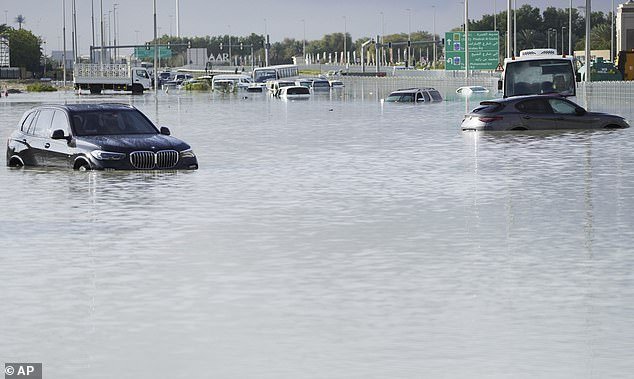
The UAE, which has just experienced devastating floods (pictured), has been using cloud seeding to increase rainfall since the 1990s. Officials deny this caused this week’s flooding
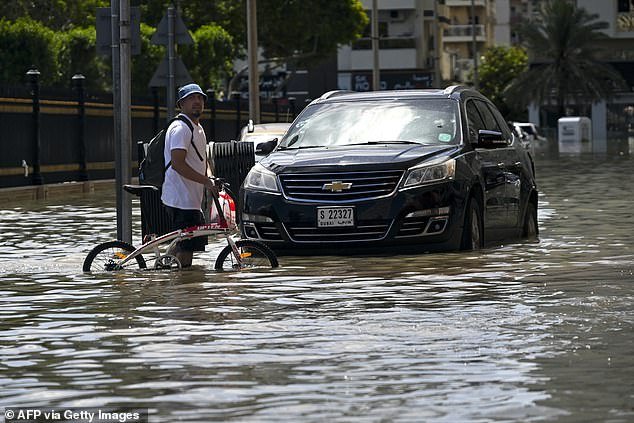
A man crosses a flooded street after heavy rain in Sharjah on April 17, 2024
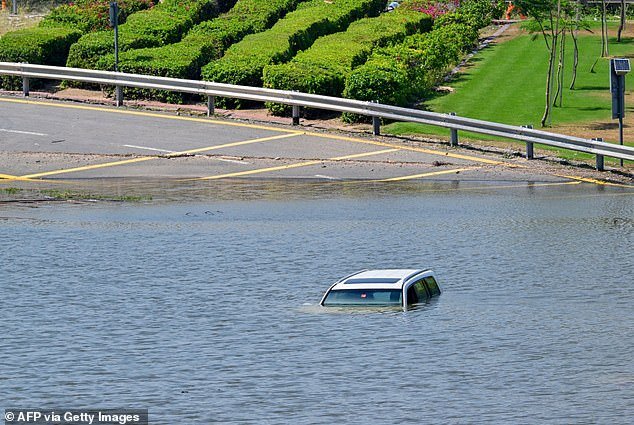
A car becomes stranded on a flooded street in Dubai after heavy rain on April 18, 2024
The rains in Dubai started late on Monday, drenching Dubai’s sands and roads with about 0.79 centimeters of rain, according to meteorological data collected at Dubai International Airport.
The storms intensified around 9 a.m. local time on Tuesday and continued throughout the day, dumping more rain and hail on the overwhelmed city.
By the end of Tuesday, Dubai had been soaked with more than 17.5 centimeters of rain for more than 24 hours.
An average of 3.73 centimeters of rain falls per year at Dubai International Airport, the world’s busiest for international travel and a hub for long-haul airline Emirates.
Authorities have canceled school and the government has introduced a work-from-home policy as the clean-up operation continues.
